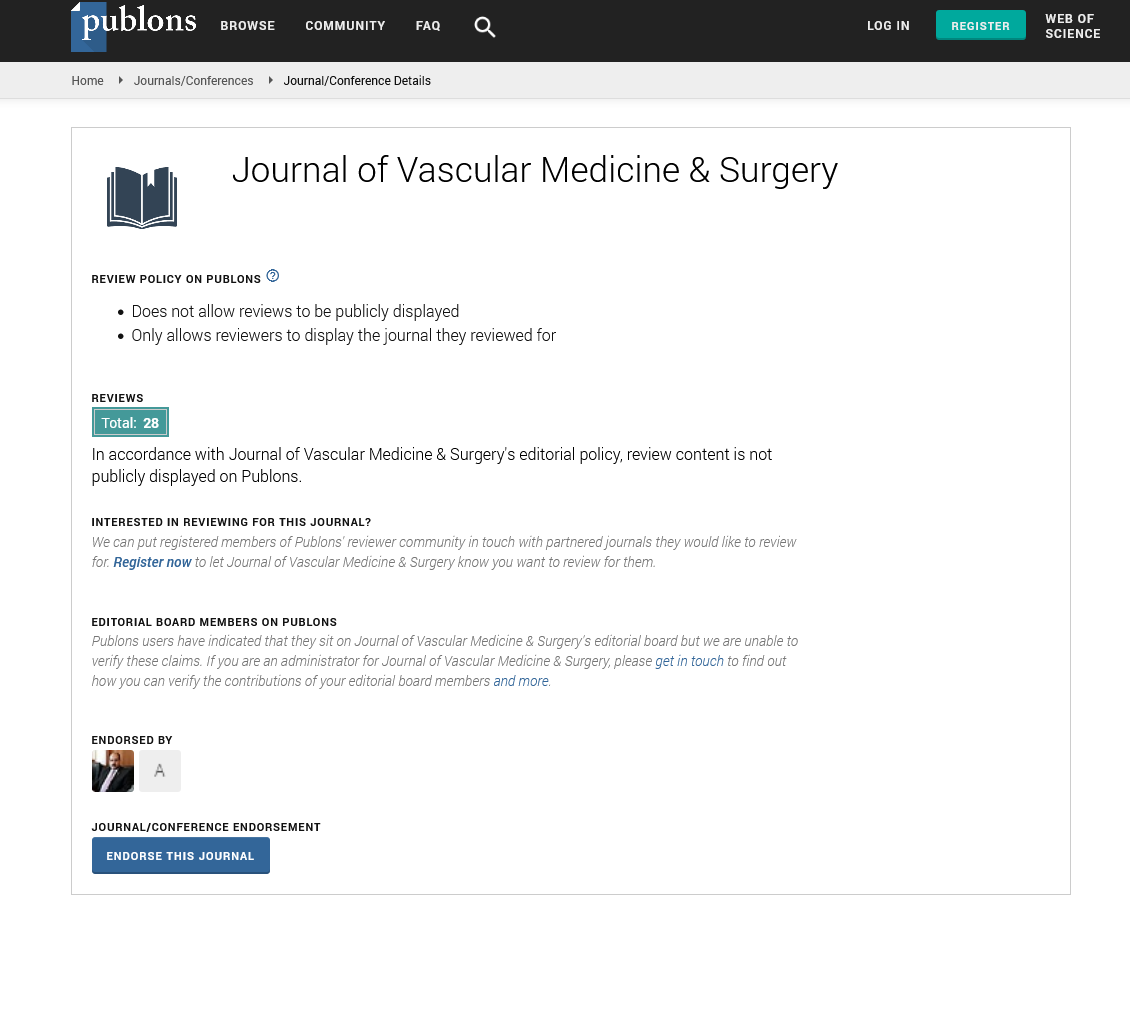Indexed In
- Open J Gate
- Academic Keys
- RefSeek
- Hamdard University
- EBSCO A-Z
- OCLC- WorldCat
- Publons
- Euro Pub
- Google Scholar
- SHERPA ROMEO
Useful Links
Share This Page
Journal Flyer

Open Access Journals
- Agri and Aquaculture
- Biochemistry
- Bioinformatics & Systems Biology
- Business & Management
- Chemistry
- Clinical Sciences
- Engineering
- Food & Nutrition
- General Science
- Genetics & Molecular Biology
- Immunology & Microbiology
- Medical Sciences
- Neuroscience & Psychology
- Nursing & Health Care
- Pharmaceutical Sciences
Commentary - (2025) Volume 13, Issue 4
The significance of Aortic Dissection Management
Yuzhen Xu*Received: 31-Mar-2025, Manuscript No. JVMS-25-28765; Editor assigned: 02-Apr-2025, Pre QC No. JVMS-25-28765 (PQ); Reviewed: 16-Apr-2025, QC No. JVMS-25-28765; Revised: 23-Apr-2025, Manuscript No. JVMS-25-28765 (R); Published: 30-Apr-2025, DOI: 10.35248/2329-6925.25.13.592
Description
Aortic dissection represents one of the most dramatic and consequential vascular emergencies, carrying significant mortality despite advances in diagnostic capabilities and treatment modalities. The traditional management paradigm has centered on a dichotomous approach: emergent surgical intervention for type A dissections involving the ascending aorta, and predominantly medical management for type B dissections limited to the descending aorta. While this framework has guided practice for decades, evolving evidence and technological innovations are prompting a more nuanced approach that considers individual patient characteristics, anatomic features, and long-term outcomes.
For type A dissections, open surgical repair remains the standard of care, with operative mortality rates of 15-30% in contemporary series. Surgical techniques have evolved to address specific anatomic challenges, including valve-sparing root replacements, arch reconstructions, and frozen elephant trunk procedures that facilitate management of distal dissection. Cerebral protection strategies during circulatory arrest have similarly advanced, with antegrade cerebral perfusion increasingly supplanting retrograde perfusion based on improved neurologic outcomes. The timing of intervention has become more individualized, with recognition that selected stable patients may benefit from transfer to specialized aortic centers despite introducing modest delays to definitive repair.
The management of type B dissections has undergone more substantial transformation, transitioning from universal medical management to a stratified approach incorporating endovascular intervention for complicated presentations. The definition of "complicated" has expanded beyond the traditional criteria of rupture, malperfusion, and refractory pain to include anatomic features that predict adverse long-term outcomes, such as false lumen diameter exceeding 22mm, entry tear diameter greater than 10mm, and partial false lumen thrombosis. This evolution acknowledges that while uncomplicated type B dissections carry relatively low short-term mortality, long-term complications including aneurysmal degeneration and rupture occur in approximately 30-40% of medically managed patients.
Thoracic Endovascular Aortic Repair (TEVAR) has emerged as the preferred intervention for complicated type B dissections, with the INSTEAD-XL and ADSORB trials demonstrating improved aorta-specific survival and remodeling compared to medical therapy alone. The goals of endovascular intervention have evolved from simply addressing immediate complications to promoting favorable aortic remodeling through entry tear coverage, true lumen expansion, and false lumen thrombosis. Advanced imaging techniques including dynamic CT angiography and 4D flow MRI have enhanced our ability to identify target entry tears and assess hemodynamic patterns that influence remodeling.
The concept of TEVAR for uncomplicated type B dissections remains controversial but is gaining traction for selected high-risk anatomic patterns. The INSTEAD-XL trial demonstrated improved 5-year outcomes with TEVAR despite similar 2-year results, suggesting delayed benefits that may not be captured in shorter-term studies. Risk stratification tools incorporating clinical and anatomic factors are being developed to identify patients most likely to benefit from early intervention despite the absence of traditional complications.
Medical management remains the foundation for all aortic dissection patients, with aggressive blood pressure control and heart rate reduction essential for limiting propagation and adverse remodeling. Beta-blockers remain first-line therapy based on their ability to reduce both blood pressure and the rate of pressure change (dP/dt), with calcium channel blockers and direct vasodilators serving as adjunctive agents. Target blood pressure parameters have become more aggressive, typically aiming for systolic pressures below 120 mmHg during the acute phase and long-term control below 130/80 mmHg, though individualization based on end-organ perfusion is critical.
Surveillance protocols have similarly evolved, with recognition that lifetime imaging is essential following aortic dissection. Standardized follow-up regimens typically include imaging at 1, 3, 6, and 12 months after presentation, then annually thereafter if stable. Magnetic resonance imaging has gained favor for long-term surveillance given the reduced radiation exposure compared to CT, particularly important for younger patients requiring lifelong monitoring. The integration of serum biomarkers including D-dimer, matrix metalloproteinases, and specific microRNAs into surveillance protocols represents an emerging frontier that may enhance risk stratification and intervention timing.
Genetic considerations have assumed increasing importance in dissection management, with recognition that approximately 20% of patients have identifiable genetic syndromes including Marfan, Loeys-Dietz, and vascular Ehlers-Danlos. These patients require more aggressive diameter thresholds for intervention, extended surveillance of non-aortic arteries, and family screening. The identification of novel genetic variants through next-generation sequencing technologies continues to expand our understanding of heritable aortopathies and refine management approaches.
Citation: Xu Y (2025). The significance of Aortic Dissection Management. J Vasc Surg. 13:592.
Copyright: © 2025 Xu Y. This is an open access article distributed under the terms of the Creative Commons Attribution License, which permits unrestricted use, distribution, and reproduction in any medium, provided the original author and source are credited.

